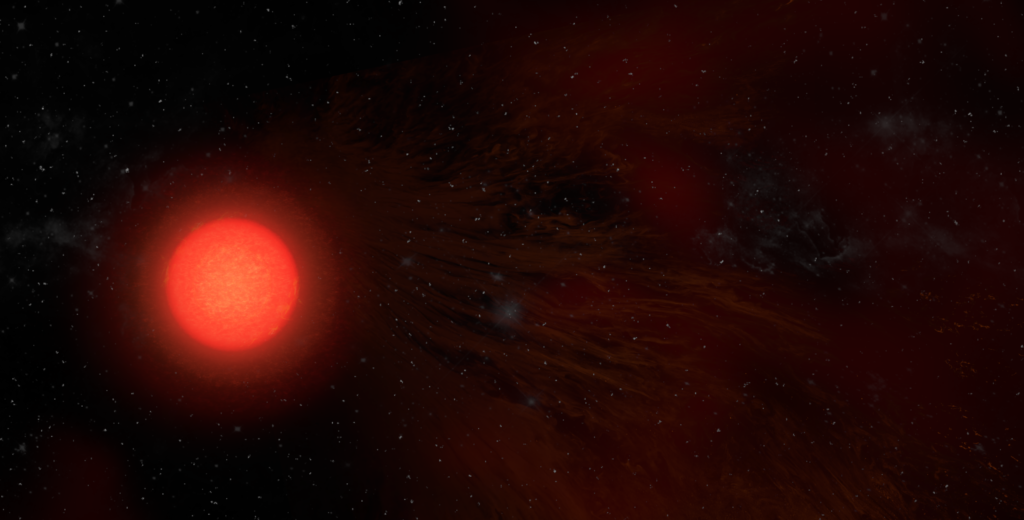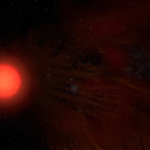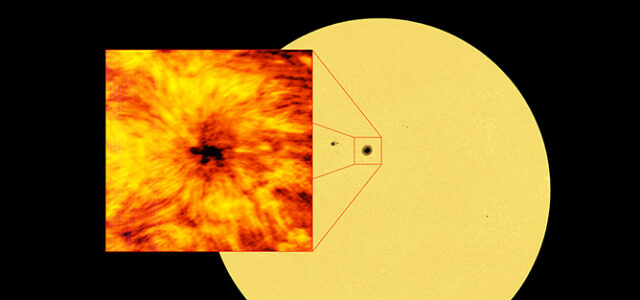Sizing up Antares
Read time: 3 minutes
So you thought the Sun is big?
True, the Sun’s diameter is more than one hundred times as large as the diameter of the Earth.
Pretty big. But some stars in our Milky Way galaxy are much larger. Using ALMA and radio telescopes
in the USA, astronomers have now measured the extent of the outermost layers of the star Antares.
And it’s huge.
Antares, in the constellation Scorpius, is one of the brightest stars in the sky, despite its distance of
some 550 light-years. Still, its surface is much cooler than the Sun’s – that’s why the star’s color is
orange-red, as opposed to the yellow color of the Sun.
Astronomers already knew that Antares is a bloated supergiant star. While the diameter of the Sun is
1.4 million kilometers, Antares is 700 times as large: about one billion kilometers across. If our Sun
would be that big, the planets Mercury, Venus, Earth, and Mars would all easily orbit inside the star,
and the star’s surface would almost reach out to the orbit of Jupiter.
However, above the visible surface of Antares is an extended, more tenuous atmosphere that is
continuously lost into space, in a strong ‘stellar wind’. The gas in this atmosphere is even cooler than
the star’s visible surface. Therefore, it doesn’t shine in visible light, but subsequently at infrared,
millimeter, and radio wavelengths, as you get further away from the star.
ALMA observations of Antares have now revealed that the so-called chromosphere of the star peaks
at a temperature of 3,500 degrees Celsius. The chromosphere is the lowest part of a star’s
atmosphere; it is being heated by magnetic fields and by the ‘boiling’ of the star’s surface. The Sun’s
chromosphere has a thickness of a ‘mere’ 3,000 kilometers or so, but Antares’s chromosphere
extends to some 750 million kilometers above the surface.
The Very Large Array radio observatory in New Mexico has also observed Antares. It found that the
cool atmosphere of the star reaches out even further, to some six billion kilometers. If Antares would
replace our Sun, the outermost planet in the Solar System (Neptune) would still orbit in this thin
atmosphere.
The new observations of Antares provide astronomers with a much more complete view of red
supergiant stars. They could also shed light on the origin of the stellar winds of these stars. That’s
important, because stellar winds from old supergiants like Antares contain elements like carbon,
nitrogen and oxygen, that are essential building blocks of life.
What?

Antares (also known as Alpha Scorpii) is the 14th-brightest star in the night sky. Its name derives from ‘anti-Ares’ – the opponent of Ares. Ares was the Greek name of Mars, the Roman god of war. The star was given that name long ago because its orange color is similar to that of Mars. Even though the star’s surface is relatively cool (as evidenced by the reddish color), it is very luminous: about 75,000 times more luminous than the Sun. That’s because the star is so incredibly large. Just like Betelgeuse in the constellation Orion, another famous red supergiant, Antares is nearing the end of its life: within a few million years or so, it will die in a titanic supernova explosion.
Who?
Antares was studied at various radio wavelengths by a large international team of astronomers, led
by Eamon O’Gorman of the Dublin Institute for Advanced Studies in Ireland. Eamon teamed up with
colleagues from the United States, Chile, Germany, Hong Kong, the United Kingdom, and Sweden.
The researchers published their results in the European journal Astronomy & Astrophysics.

ALMA URL



